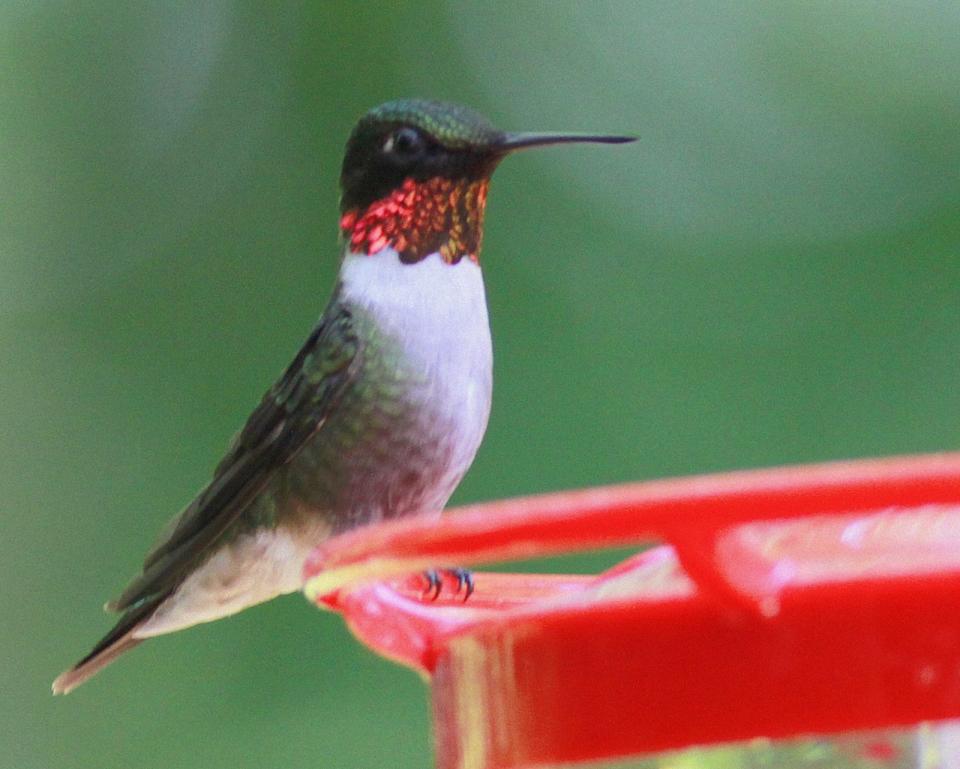Tips on using your hummingbird feeder so you can see them once more before they leave NJ
The ruby-throated hummingbird that has been feeding on flower nectar in your yard is getting ready to make a trip to the Gulf Coast, but that's just the first half of its fall schedule.
A good part of that trip is across the Gulf of Mexico, a 500-mile, 20-hour trip to Mexico or Central America, where it will spend the winter.
It also will be going solo. Unlike geese, ducks and other migrating birds, hummingbirds don't "flock together." Even the babies hatched this past spring are born with an internal map and know the way.
The male, which carries the namesake color for the species, weighs just over 3 grams. For comparison, a penny weighs 3 grams. Males have a wingspan of 3 to 4.3 inches. The female is slightly larger.
And ruby-throated hummingbirds are the only hummingbird species that breeds in New Jersey. Rufous hummingbirds are often seen in the state, which more rarely also gets the black-chinned, calliope and Allen's species.
When do hummingbirds leave NJ?

The ruby-throated birds are beginning to leave the state for that annual trip about now and are in "feeding frenzy" mode. Some start leaving New Jersey in late July to head south. They typically all leave by mid-September.
Hummingbird feeders can keep them close until then but won't stop them from migrating south in the winter.
Hummingbird feeders
If you have hummingbird feeders, you have been using a 4-to-1 ratio of water to white cane sugar — with no food coloring. The feeder does the attracting.
However, birding experts at the Cornell Lab of Ornithology note that in the fall, as the birds instinctively look to stock up on calories, switching to a 3-to-1 ratio of water to sugar will help.
Also, pay more attention to the level of sugar water in the feeder, because there will be more birds using it. The migration from farther north has already begun, and the number of birds around your feeder will rise with the southbound visitors.
Increasing the calories available here will also help the birds that have spent the summer around "their" feeders. Hummingbirds are extremely territorial, leading to more chasing because of more "stranger" visits.
In addition to regular hummingbird feeders that are filled with sugar water, there now are feeders that use an attractant, such as chopped fruit or bananas, to draw the small flying insects that make up a large part of a hummingbird's diet.
Meteor Meteor lights up sky in New Jersey and Mid-Atlantic. Check it out
The birds also need proteins, vitamins and fats, all provided by small, soft-bodied insects, including mosquitoes, spiders, gnats, fruit flies, aphids, ants and small beetles, which can be swallowed easily.
So you have gone through the effort to provide for hummingbirds, and what reward do you get?
Do hummingbirds recognize people?
In addition to the fun of watching them, new research has shown that hummingbirds actually recognize the humans who feed them regularly. They are able to identify the differences between a threatening predator and someone who regularly provides them with food.
With the use of patience and a hand-held feeder, you may be able to get a hummingbird to come up to you, even resting on a finger or shoulder.
But with all that extra nectar supply available, other animals, such as bears and squirrels, are also looking to calorie-up for the winter. So be sure the hummingbird feeders, as well as other birdfeeders in your yard, are inaccessible to four-legged raiders.
When you do take down your hummingbird feeders — maybe over a long Thanksgiving weekend — take the extra time to thoroughly wash and inspect all parts of the feeders. And store them away as parts and pieces, not assembled. You will still want to wash them again next spring before you hang them up, likely around "Tax Day" (April 15).
This article originally appeared on New Jersey Herald: When do hummingbirds leave New Jersey? Here's the answer

